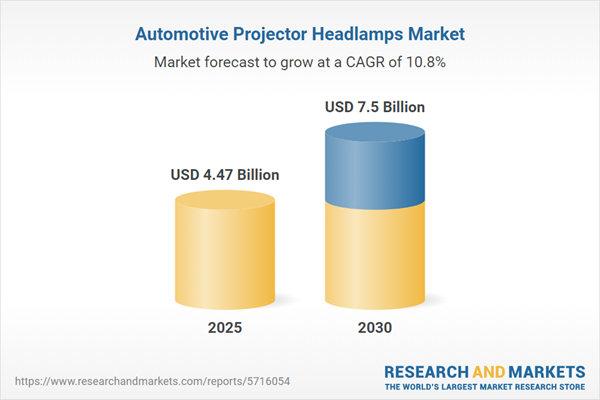Speak directly to the analyst to clarify any post sales queries you may have.
Senior decision-makers in the automotive sector face ongoing complexity as procurement evolves to meet technological, regulatory, and regional demands. Navigating the intricacies of the automotive projector headlamps market is crucial for ensuring streamlined operations and supporting long-term, market-driven growth.
Market Snapshot: Automotive Projector Headlamps Market
The global automotive projector headlamps market continues an upward trajectory, propelled by rapid innovation and an increased focus on safety. In 2024, the market is valued at USD 4.04 billion and projected to reach USD 4.47 billion by 2025, with longer-term expectations rising to USD 7.50 billion by 2030. This represents a robust compound annual growth rate (CAGR) of 10.84%. Market drivers include rising demand for advanced headlamp technologies, a focus on more resilient and regionalized supply chains, and adaptive approaches to procurement—all critical considerations for sustaining a competitive edge in this evolving marketplace.
Scope & Segmentation
This report provides actionable insights aligned with the unique requirements of senior procurement professionals, outlining the leading market forces and segment drivers shaping projector headlamp adoption and sourcing decisions.
- Technology: Analysis explores halogen, HID, and LED headlamps, evaluating their energy efficiency, integration capacity, and lifespan improvements as they relate to newer vehicle platforms.
- Beam Type: Comparative overview of single vs. dual beam systems, including considerations for reliability, safety, and integration with advanced controls.
- Installation: Discussion covers both OEM-direct and retrofit installations, highlighting regulatory compliance and the impact of aftermarket options on commercial and passenger fleets.
- Distribution Channel: Insights into OEM-direct and aftermarket supply models, considering procurement efficiency, supply partnerships, and the ability to fortify the value chain.
- Vehicle Type: Contrasts procurement needs for commercial and passenger vehicles, with attention to compliance, deployment priorities, and operational requirements.
- Regional Coverage: Evaluates procurement and market trends across the Americas, Europe, Middle East, Africa, and Asia-Pacific, while focusing on strategic markets such as the United States, Germany, China, and India.
- Companies Featured: Profiles key companies, including Continental AG, KOITO MANUFACTURING CO., LTD., ams OSRAM AG, Magna International Inc., Marelli Holdings Co., Ltd., Uno Minda Limited, Stanley Electric Co., Ltd., Valeo S.A., ZKW Group GmbH (LG Corporation), Koninklijke Philips N.V., Texas Instruments Incorporated, Fiem Industries Limited, and Lumileds Holding B.V.
Key Takeaways
- Projector headlamp solutions are central to supporting both safety mandates and operational reliability for automotive fleets and passenger vehicles.
- Advancements in LED and adaptive headlamp systems help streamline maintenance, enable firms to meet evolving regulations, and expand new market opportunities for forward-looking OEMs and suppliers.
- The adoption of advanced semiconductor components within headlamp systems enhances real-time adaptation, allowing for improved oversight and vendor benchmarking.
- Differing procurement priorities emerge: commercial segments focus on sourcing dependability and regulatory compliance, while passenger vehicle producers seek seamless integration and a refined end-user experience.
- Aligning procurement approaches to regional dynamics enhances outcomes—aftermarket channels are prominent in the Americas, regulatory-focused sourcing is critical in Europe, the Middle East, and Africa, and efficiency-oriented practices dominate the Asia-Pacific landscape.
Tariff Impact
Recent U.S. tariff updates are prompting automotive projector headlamp suppliers to revisit their global manufacturing and sourcing strategies. Increasingly, production shifts to Southeast Asia and Latin America support cost containment and greater supply continuity. Concurrently, in-house production expansion and component redesign have become vital for bolstering resilience amid shifting trade landscapes.
Methodology & Data Sources
Market findings draw from direct interviews with senior executives from top OEMs and suppliers, supplemented by insights gathered from regulatory authorities, specialized industry surveys, patent analysis, and a cross-sectional review of performance benchmarks. This approach ensures data reliability, comprehensiveness, and a solid foundation for market intelligence.
Why This Report Matters
- Equips procurement and supply chain leaders with targeted guidance to address regulatory shifts and technology transformations in automotive lighting markets.
- Offers direct, actionable insights for OEMs and fleet managers, supporting the development of adaptive regional procurement models and supplier strategies.
- Provides senior executives with robust tools to manage risk and optimize sourcing decisions through comprehensive regulatory and technology analyses.
Conclusion
Navigating the evolving automotive projector headlamps market requires agile procurement and sustained attention to innovation. Prioritizing compliance and technology adaptation remains essential for delivering resilient and future-ready operations.
Additional Product Information:
- Purchase of this report includes 1 year online access with quarterly updates.
- This report can be updated on request. Please contact our Customer Experience team using the Ask a Question widget on our website.
Table of Contents
3. Executive Summary
4. Market Overview
7. Cumulative Impact of Artificial Intelligence 2025
Companies Mentioned
The companies profiled in this Automotive Projector Headlamps market report include:- Continental AG
- Fiem Industries Limited
- Guangzhou AES Electronic Technology Co., Ltd.
- FORVIA Group
- HYUNDAI MOBIS CO., LTD
- KOITO MANUFACTURING CO., LTD.
- Lumax Industries Limited
- Magna International Inc.
- Marelli Holdings Co., Ltd.
- Uno Minda Limited
- Neolite ZKW Pvt. Ltd.
- ams OSRAM AG
- Robert Bosch GmbH
- SL Corporation
- Stanley Electric Co., Ltd.
- Clarience Technologies
- Valeo S.A.
- Varroc Group by Plastic Omnium
- ZKW Group GmbH by LG Corporation
- Two Brothers Inc.
- Koninklijke Philips N.V.
- Texas Instruments Incorporated
- Lumileds Holding B.V.
- Roots Industries India Private Limited
Table Information
| Report Attribute | Details |
|---|---|
| No. of Pages | 196 |
| Published | November 2025 |
| Forecast Period | 2025 - 2030 |
| Estimated Market Value ( USD | $ 4.47 Billion |
| Forecasted Market Value ( USD | $ 7.5 Billion |
| Compound Annual Growth Rate | 10.8% |
| Regions Covered | Global |
| No. of Companies Mentioned | 25 |









